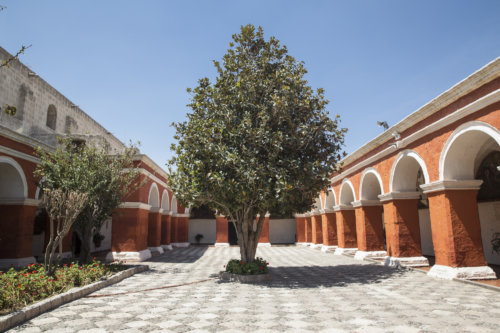
A Centuries-Old Peruvian Monastery Reconciles Its Controversial Past
Though the idea for the monastery began with a request by town leaders to Viceroy Francisco Toledo, it was a young, wealthy, childless widow named Maria de Guzman who ultimately saw the construction of Monasterio de Santa Catalina, located in Arequipa, Peru, to completion in 1579. Bereft of any familial connections or obligations, Maria de Guzman retired behind her investment’s protective walls and donated to it all her earthly possessions. The following year, the sanctuary was officially opened, and Maria de Guzman (Dona Maria) formally donned her habit, and was formally recognized as the founder of what has since become a beautiful natural space in a historically rich region of Peru.
Today, the monastery houses some 20 nuns (with the rest of the space being open to public visitors), who in addition to their religious duties, are occupied with caring for the splendid gardens, and turning the herbs they grow into natural soaps and cremes– the perfect picture of sober reflection and humble living. Historically, however, the monastery was a source of controversy, as it increasingly (in the ensuing centuries after its opening) admitted only daughters from wealthy families who were obligated to pay stiff entry fees. Comfortable in their pampered lives, the daughters would bring servants along with them to attend to the less glamorous tasks, like laundry and cleaning. Rather than a life in servitude, apart from the world, the nuns of Monasterio de Santa Catalina threw lavish parties with musicians and used silver cutlery.
“Today, the monastery houses some 20 nuns, who– in addition to their religious duties– are occupied with caring for the splendid gardens, and turning the herbs they grow into natural soaps and cremes.”
In the later half of the 1800s, all that came to end. Pope Pius IX sent Sister Josefa Cadena, a strict Dominican nun, to the monastery to restore order. The wealthy daughters were returned to the families, and the servants were offered a choice between leaving or staying on service to God, restoring the space to its original intent.
In the 1970s, the monastery was opened to the public, when the local government insisted the space be brought up to code and installed with electricity and a modern water system. To cover the costs, the nuns opened much of the monastery up to the public, and it has thrived ever since.
With its intricate alley system and tall walls, the monastery (which occupies an entire city block) is like its own small village, dotted with papaya, avocado, lemon, and magnolia trees, hedges of rhododendron, cacti, herbs, and colorful blooms like geraniums, roses, and lantanas. Fountains set in squares grow symmetric waterlilies, and many of the walls are painted in vivid, saturated hues, creating an altogether paradise-like effect. Within sight of Rio Chili at the heart of the city, the monastery keeps history alive, enticing visitors with its breathtaking views.
To plan a visit to the Monasterio de Santa Catalina, visit the monastery’s website.








































